Revised May 12, 2010
June 5, 2009
NOTICE:
THIS FIELD NOTICE IS PROVIDED ON AN "AS IS" BASIS AND DOES NOT IMPLY ANY KIND OF GUARANTEE OR WARRANTY, INCLUDING THE WARRANTY OF MERCHANTABILITY. YOUR USE OF THE INFORMATION ON THE FIELD NOTICE OR MATERIALS LINKED FROM THE FIELD NOTICE IS AT YOUR OWN RISK. CISCO RESERVES THE RIGHT TO CHANGE OR UPDATE THIS FIELD NOTICE AT ANY TIME.
Revision History
Revision Date Comment
Products Affected
Products Affected
Problem Description
CRS-1 OC768-ITU/C PLIMs that match the list of affected Serial Number may encounter intermittent bursts of High BER events or loss of transmitted optical power after several months of operation. Three different failure mechanisms have been identified in Background section below.
Background
The background for three different failure mechanisms are identified:
- Dendrite Growth within Mux/Demux components: A dendrite is a tree-like branching conductive structure, formed by a metal or an alloy of multiple metals. Mux/Demux components are used within the OC768 Optics Module on the CRS1 OC768-ITU/C PLIMs. Contamination resulting from the assembly process and materials used in the packaging of these Mux/Demux components may result in corrosion and dendrite growth over a period of time, on the susceptible PLIMs. Dendrite growth may be accelerated by operational conditions, especially temperature. Failures are seen when the dendrites grow long enough to bridge and short out capacitors within the Mux/Demux components. Failure will first show up as intermittent bursts of high BER (bit-error rate), leading to link-flaps. Eventually dendrite growth will force a hard failure (link down) on the Optics.
- Laser Facet Coating: Laser power in the active region is dependent on several factors including current, etching, and facet coating. Laser coating issues on the front facet may lead to optics performance degradation over a period of time, on the susceptible list of OC768-ITU/C PLIMs. This defect will typically manifest itself on a sub-set of wavelengths, and will result in low or zero output power from the OC768 optics module.
- L25 Inductor: An inductor coil used at location L25 on the optics module did not provide adequate margin for all extreme conditions. As a result, inductance derating at high temperature may initialize saturation and a cyclic peak current within the coil. This condition may lead to gradual temperature rise until coil insulation is shorted, leading to a loss of optical transmit power on the susceptible OC768-ITU/C PLIMs. This failure may also manifest itself over a period of time, depending on operating conditions including temperature
Problem Symptoms
- Dendrite growth will lead to intermittent bursts of high BER. This will lead to link flaps on the OC768 interface. Over time, these link flaps may increase in frequency until eventually a hard (persistent) link failure condition is seen.
- Laser facet coating issue will affect optical power degradation on a sub-set of wavelengths. This will also manifest itself as link-flaps.
- L25 Inductor failure will lead to loss of power to OC768 Optics module over a period of time. With the Optics module powered down, no transmit optical output will be seen from failed OC768-ITU/C PLIM.
Workaround/Solution
Cisco recommends replacing the affected hardware (1OC768-POS-ITU/C). Refer to Figure 2 for TAN number, serial number.
TAN Number Affected Serial Number Match Action 800-18052-04 Not applicable No Action required. Card is updated. 800-18052-03 Check serial number, if Affected -> Action Inspect Inductor L25. If date code is 0628 or older, request RMA with Failure code AFN, FN63126. 800-18052-02 Check Serial number, if Affected -> Action Request RMA with Failure code AFN, FN63126. 800-18052-01 Check Serial number, if Affected -> Action Request RMA with Failure code AFN, FN63126. If your card does not match in above table, no action is required.
How To Identify Hardware Levels
Complete these steps in order to check the hardware level of the boards:
- Execute the show diag command as seen below to check the 800 TAN number and deviation number or physically at card (refer to figure):
RP/0/RP0/CPU0:CRS4A#sh diag 0/3/cpu0
Sun Apr 6 09:24:38.258 PST
PLIM 0/3/CPU0 : Cisco CRS-1 OC768 (C-band) DWDM PLIM
MAIN: board type 600097
800-18052-01 rev 38<------------- TAN # is here
dev 098101<----------------- Deviation # is here
S/N SAD103304GK <-----Serial number
PCA: 73-7218-02 rev 16
PID: 1OC768-ITU/C
VID: V01
CLEI: IPUIAXSRAA
ECI: 141603
Board State : IOS XR RUN
PLD: Motherboard: 0x0025, Processor: 0xda13, Power: N/A
MONLIB: QNXFFS Monlib Version 3.1
ROMMON: Version 1.48(20070928:224557) [CRS-1 ROMMON]
Interface port config: 1 Ports
Optical reach type: N/A
Connector type: N/A
Figure 1: Card View
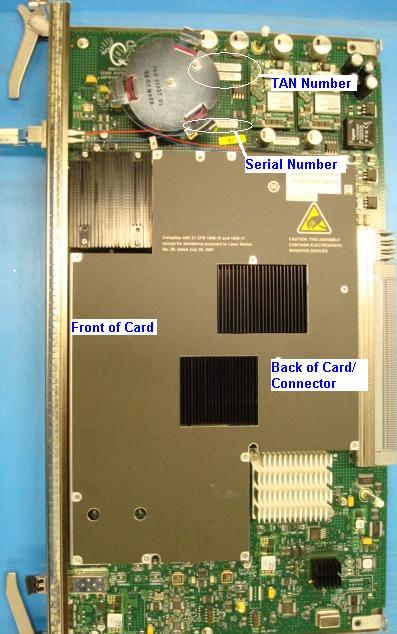
Figure 2: Card Close-up View
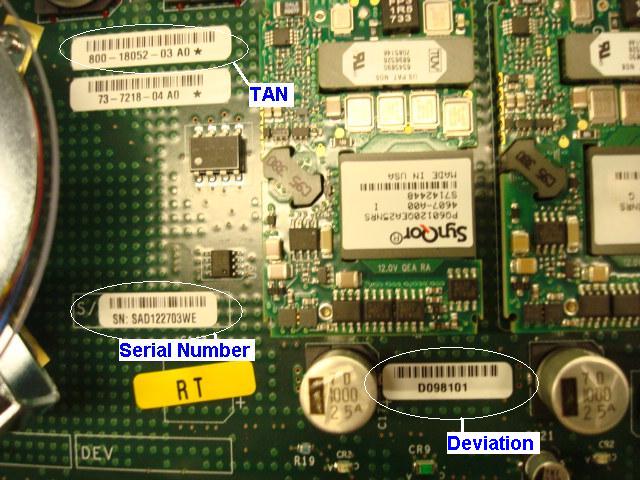
- If the TAN is 800-18052-04 or higher, the 1OC768-ITU/C is upgraded and does NOT need replacing. No further checks are necessary.
- If TAN is 800-18052-03 with deviation D098101 and your card serial number validate as "Affected" in Cisco Serial Number Validation Tool, inspect for L25 inductor date code (location 'A' in figures 3 and 4). If date code is earlier than 0628, Cisco recommends replacement of suspect unit, please follow Cisco RMA guidelines and use Failure code AFN with Field notice number to request replacement.
Refer to Figure 3 for inductor location 'A', figure 4 is L25 inductor with date code 0712 is good inductor. Inductor in location B and C shown for reference only in figure 5 and 6 respectively.
Figure 3: Card view - L25 Location
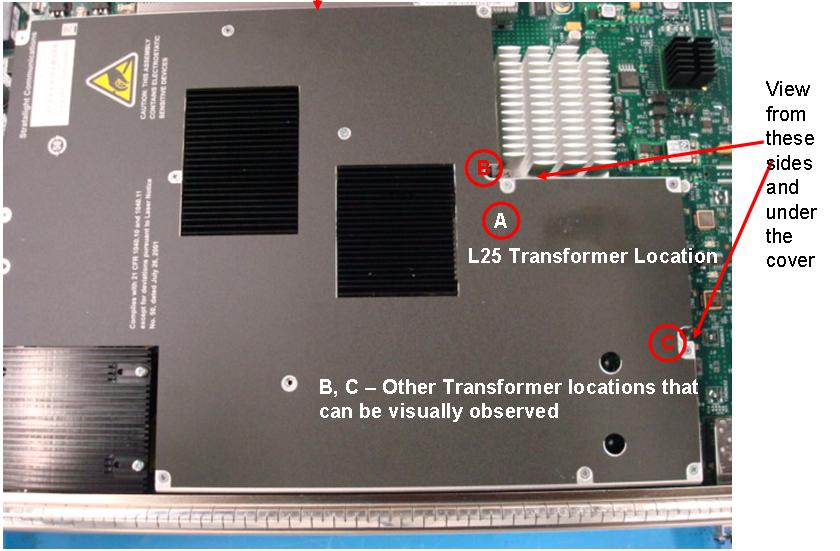
Figure 4: L25 Inductor Location A
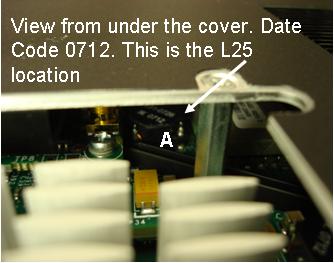
Figure 5: Inductor B
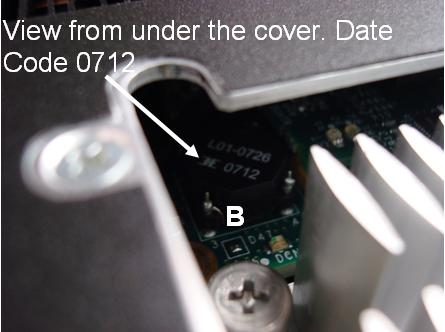
Figure 6: Inductor C
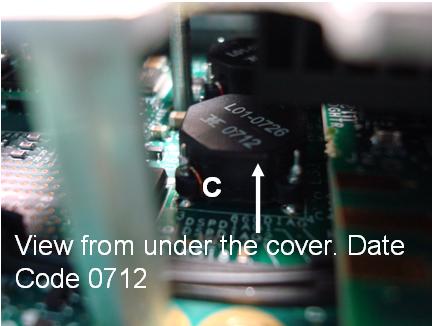
- If the TAN is 800-18052-02 or lower and your card serial number validate as "Affected" in Cisco Serial Number Validation Tool,, Cisco recommends replacement of suspect unit, please follow Cisco RMA guidelines and use Failure code AFN with Field notice number to request replacement.
Deviation
D094924
D098101
For More Information
If you require further assistance, or if you have any further questions regarding this field notice, please contact the Cisco Systems Technical Assistance Center (TAC) by one of the following methods:
Receive Email Notification For New Field Notices
Cisco Notification Service - Set up a profile to receive email updates about reliability, safety, network security, and end-of-sale issues for the Cisco products you specify.